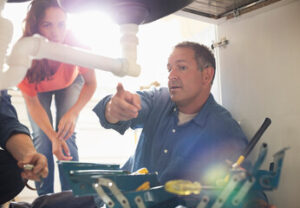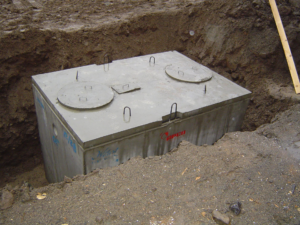Plumbing Services ensure that water and waste are transported through pipes in a safe and efficient manner. Whether it’s fixing a dripping faucet or unclogging a stubborn drain, skilled plumbers have the tools and know-how to get the job done right.

A professional plumber can also detect leaks before they become major problems and save you money in the long run by repairing them as soon as possible. Contact Got Flow Plumbing & AC Services for professional help.
The plumbing system in your home can become clogged with food, hair, soap scum, grease and other debris that collects and restricts water flow. When these issues are left untreated or ignored, it can lead to sewage back-ups, drain odor, flooding and other severe plumbing problems. Regular drain cleaning helps prevent these issues, saving homeowners money and stress in the long run.
A professional drain cleaning service utilizes a variety of tools and techniques to thoroughly clean the entire drainage system. Technicians begin with a thorough assessment, often using advanced technology like drain cameras to pinpoint the source and extent of the issue. They can then use specialized equipment to remove obstructions and restore proper water flow. This can include snaking the drain with a flexible cable or hydro-jetting, which uses high-powered water to break up and remove blockages.
While some clogs can be resolved with homemade solutions such as hot water, baking soda and vinegar, many require more extensive tools to resolve. Attempting to remove a major clog with a plunger can result in further damage to the pipes and plumbing components. Professional plumbers are trained to locate and isolate clogs without risking further damage, and can use more effective methods such as a drain snake or hydro-jetting.
Another common cause of drain clogs is tree roots. When searching for moisture, the roots of trees can penetrate pipes and create a blockage. Preventing this issue requires a proactive approach, including planting trees far from sewer lines and installing root barriers. Regular inspections from a qualified professional can also help identify and address the problem early on, minimizing damage.
Drain cleaning services are a must for any home or business, but they can be easy to overlook. However, regular maintenance is one of the most important things you can do to ensure that your drains and plumbing system are functioning at their best. By preventing issues and addressing them as they arise, you can save yourself the hassle, expense and stress of a major plumbing disaster.
Clogged Toilet
Clogged toilets can cause a lot of problems for your home. Not only are they unsightly, but they can also lead to water damage and promote bacteria growth in the area surrounding the clogged drain. They can also cause foul odors that affect the quality of life in your home. Fortunately, a plumber can easily fix most clogged toilets.
First, try to determine where the clog is located. If the clog is in the trap, which is the curved portion of pipe under the toilet, you may be able to clear it with a plunger or plumbing snake (also called an auger). However, if the clog is further down in the drainpipe or sewer line, you will need a professional plumber.
A professional plumber will have specialized tools that can be used to remove even the most stubborn clogs without damaging your pipes or toilet. They can use a variety of techniques to dislodge clogs including manual and motorized drain snakes, high-definition cameras for drains and sewer lines, and hydro-jetting machines.
Be sure to wear gloves and take precautions when addressing a clogged toilet. It can contain dangerous bacteria and other contaminants. Once you have cleared the clog, be sure to thoroughly clean and disinfect your hands and any tools you have used.
Persistent clogs that won’t go away are a sign of a bigger issue, such as a broken or cracked pipe or sewage backup. These issues require professional help to prevent further damage to your home and health risks for you and your family.
Another sign of a larger problem is when multiple drains in your home are slow to drain. This could indicate that there is a clog in the main drain line that connects all of your home’s drainpipes. A clog in this line can occur for many reasons and can be difficult to resolve, but a plumber will be able to find the source of the problem quickly and safely. This can save you a lot of money in repair bills. They can also detect and address any leaks that may be occurring around the base of your toilet.
Clogged Sink
When sinks drain slowly, it’s a clear indication that you need to get a hold of your plumbing system. The good news is that clogged sinks are usually easy to fix for homeowners with a bit of elbow grease and some DIY know-how. Using a few tried and true methods like plunging, baking soda, and vinegar, you can unclog most drains.
The most common cause of a clogged sink is food waste. This includes leftovers from meals, snacks, and even pet food. Grease and oil are another culprit because they can build up on top of other food waste in the pipe. This slows water flow and causes a clog over time. Be sure to dispose of these items in a grease trap or garbage disposal and stop pouring fats down the sink drain.
A simple way to remedy a minor clog is by using salt and baking soda. The mixture of these two materials creates a reaction that pushes the clog down the pipes. This is especially effective if you add boiling water to the mix. Be sure to use a strainer or stopper over the drain to catch any clog-causing debris that may fall out of the pipes.
If the above tips don’t work, it’s time to call a plumber. Plumbers have tools that can dislodge stubborn clogs and diagnose larger problems in the plumbing system. Plumbers can also fix leaky faucets and inspect the drainage systems for signs of damage.
Keeping up with your home’s maintenance is the best way to prevent clogged drains and other plumbing issues. A clogged kitchen or bathroom drain is not something to ignore, but rather an issue that should be resolved quickly. It’s best to hire a plumber for issues that don’t respond well to DIY solutions so that the problem doesn’t worsen. If you have a recurring clogged sink, contact Jarboe’s for expert plumbing services in Louisville. Our team will keep your drains running smoothly!
Clogged Sewer
Almost every homeowner will experience a clogged drain at some point, but when multiple household fixtures begin to back up at once it can be a major nuisance and even a health hazard. If you suspect a sewer line clog, it’s important to take action immediately to prevent the issue from worsening and protect your home.
The most common cause of a clogged sewer line is accumulated debris inside the line’s piping. This can include grease, fats, and non-flushable items like baby wipes that are not disposed of correctly. The resulting blockage prevents waste and sewage from properly draining away, causing immediate and frequent backups.
Another common cause of a clogged sewer pipe is structural damage to the line. This can be caused by tree roots, misaligned joints, or broken or collapsed pipes. In these cases, a professional plumber can diagnose the problem through a detailed sewer camera inspection and recommend the appropriate solutions to restore your line.
In some cases, the repair process will require a full excavation of your property’s sewer lateral and/or a section of the city’s mainline. This can lead to temporary street closures and traffic disruptions. If you’re concerned about the impact this could have on your daily routine, it’s a good idea to inquire about potential timelines and any preparations you might need to make.
Effective communication with city officials can help to speed up the resolution of any suspected issues with your city sewer line. Be sure to always document your communications, including any requests you may need to make and responses from city representatives.
It’s also a good idea to ask your local municipality about any policies or programs that might help homeowners cover the cost of repairs and cleanup related to city-owned sewer lines. It’s also a good idea to have a plan in place for emergency situations, like raw sewage backups that pose serious health risks.
Don’t hesitate to reach out to a professional plumber with any questions about your plumbing system. They can help you identify the source of your problem and recommend the right solutions to get it under control so you can enjoy a stress-free home environment again soon.


